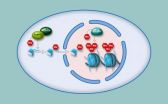(Press-News.org) ITHACA, N.Y. — For more than 50 years, language scientists have assumed that sentence structure is fundamentally hierarchical, made up of small parts in turn made of smaller parts, like Russian nesting dolls. But a new Cornell University study suggests language use is simpler than they had thought.
Co-author Morten Christiansen, Cornell professor of psychology and co-director of the Cornell Cognitive Science Program, and his colleagues say that language is actually based on simpler sequential structures, like clusters of beads on a string.
"What we're suggesting is that the language system deals with words by grouping them into little clumps that are then associated with meaning," he said.
Sentences are made up of such word clumps, or "constructions," that are understood when arranged in a particular order. For example, the word sequence "bread and butter" might be represented as a construction, whereas the reverse sequence of words "butter and bread" would likely not.
The sequence concept has simplicity on its side; language is naturally sequential, given the temporal cues that help us understand and be understood as we use language. Moreover, the hierarchy concept doesn't take into account the many other cues that help convey meaning, such as the setting and knowing what was said before and the speaker's intention.
The researchers drew on evidence in language-related fields from psycholinguistics to cognitive neuroscience. For example, research in evolutionary biology indicates that humans acquired language (and animals did not) because we have evolved abilities in a number of areas, such as being able to correctly guess others' intentions and learn a large number of sounds that we then relate to meaning to create words. In contrast, the hierarchy concept suggests humans have language thanks only to highly specialized "hardware" in the brain, which neuroscientists have yet to find.
Research in cognitive neuroscience shows that the same set of brain regions seem to be involved in both sequential learning and language, suggesting that language is processed sequentially. And several recent psycholinguistic studies have shown that how well adults and children perform on a sequence learning task strongly predicts how well they can process the deluge of words that come at us in rapid succession when we're listening to someone speak. "The better you are at dealing with sequences, the easier it is for you to comprehend language," Christiansen said.
The study by Christiansen and his colleagues has important implications for several language-related fields. From an evolutionary perspective, it could help close what has been seen as a large gap between the communications systems of humans and other nonhuman primates. "This research allows us a better understanding of our place in nature, in that we can tie our language ability, our communication abilities, more closely to what we can see in other species. It could have a big impact in terms of allowing us to think in more humble terms about the origin of language in humans," Christiansen said.
The research could also affect natural language processing, the area of computer science that deals with human language, by encouraging scholars to focus on sequential structure when trying to create humanlike speech and other types of language processing, Christiansen said. He pointed out that machines already successfully perform such tasks as translation and speech recognition thanks to algorithms based on sequential structures.
### The study, "How hierarchical is language use?" was published Sept. 12 in the Proceedings of the Royal Society B: Biological Sciences (http://bit.ly/RUGa7E). The research was funded by the European Union, the Netherlands Organization for Scientific Research and the Binational Science Foundation.
Contact Syl Kacapyr for information about Cornell's TV and radio studios.
Language use is simpler than previously thought, finds Cornell study
2012-09-25
ELSE PRESS RELEASES FROM THIS DATE:
Study of cigarette and waterpipe tobacco smoking shows knowledge gap in perceived health risks
2012-09-25
RICHMOND, Va. (Sept. 25, 2012) – People who smoke both cigarettes and waterpipes – dual users – lack sufficient knowledge about the risks of tobacco smoking and are at considerable risk for dependence and tobacco-related diseases, such as cancer, heart disease and stroke later in life, according to findings of a new study by Virginia Commonwealth University.
The study, the first of its kind to assess trends in cigarette and waterpipe tobacco smoke based on long-term data, reveals few users perceive dangers of waterpipe tobacco. A common misconception about waterpipe ...
Mechanism that leads to sporadic Parkinson's disease identified
2012-09-25
New York, NY (September 25, 2012) — Researchers in the Taub Institute at Columbia University Medical Center (CUMC) have identified a mechanism that appears to underlie the common sporadic (non-familial) form of Parkinson's disease, the progressive movement disorder. The discovery highlights potential new therapeutic targets for Parkinson's and could lead to a blood test for the disease. The study, based mainly on analysis of human brain tissue, was published today in the online edition of Nature Communications'.
Studies of rare, familial (heritable) forms of Parkinson's ...
News consumption of political stories not enough to retain political knowledge
2012-09-25
A strong democracy depends on smart voters who choose their leaders based on their knowledge of important political issues. One of the ways that Americans learn about politics is by following the news. Now, researchers from the University of Missouri School of Journalism have found that simply following the news is not enough.
A panel survey involving more than 1,200 teenagers from 12 to 17 years of age found that adolescents learn more about politics when they think and talk about what they read or watch on the news. Edson Tandoc, a doctoral student at MU, found that ...
JoVE article shows steps to isolate stem cells from brain tumors
2012-09-25
September 25, 2012
A new video protocol in Journal of Visualized Experiments (JoVE) details an assay to identify brain tumor initiating stem cells from primary brain tumors. Through flow cytometry, scientists separate stem cells from the rest of the tumor, allowing quick and efficient analysis of target cells. This approach has been effectively used to identify similar stem cells in leukemia patients.
"Overall, these tumors are extremely rare, with only around one in 100,000 people being diagnosed with a primary brain cancer," Dr. Sheila Singh, co-author and neurosurgeon ...
Making and breaking heterochromatin
2012-09-25
This press release is available in German.
To fit the two-meter long DNA molecule into a cell nucleus that is only a few thousandths of a millimetre in size, long sections of the DNA must be strongly compacted. Epigenetic marks maintain these sections, known as heterochromatin. Scientists of the Max Planck Institute of Immunobiology and Epigenetics in Freiburg have now discovered two further mechanisms necessary for the formation of heterochromatin. The research group, led by Thomas Jenuwein, describes two novel enzymes, Prdm3 and Prdm16, which attach a methyl group to ...
Treatment for alcoholism dramatically reduces the financial burden of addiction on families
2012-09-25
The financial effects of alcoholism on the family members of addicts can be massive, but little is known about whether treatment for alcoholism reduces that financial burden. A study of 48 German families published online today in the journal Addiction reveals that after twelve months of treatment, family costs directly related to a family member's alcoholism decreased from an average of €676.44 (£529.91, US$832.26) per month to an average of €145.40 (£113.90, $178.89) per month. Put another way, average costs attributable to alcoholism decreased from 20.2% to 4.3% of ...
Model confirms active surveillance as viable option for men with low-risk prostate cancer
2012-09-25
PHILADELPHIA — A new research model has estimated that the difference in prostate cancer mortality among men with low-risk disease who choose active surveillance versus those who choose immediate treatment with radical prostatectomy is likely to be very modest, possibly as little as two to three months.
The model, developed by biostatistician Ruth Etzioni, Ph.D., and colleagues of the Public Health Sciences Division at Fred Hutchinson Cancer Research Center in Seattle, Wash., is among the first to use specific data from published studies to project the likelihood of ...
Video: 3-D time-lapse imaging captures twisted root mechanics for first time
2012-09-25
ITHACA, N.Y. — Using an advanced 3-D time-lapse imaging system, a group of physicists and plant biologists from Cornell University and the Boyce Thompson Institute for Plant Research have discovered how certain plant roots exhibit powerful mechanical abilities while navigating their environment.
The research, published in this week's online Early Edition of Proceedings of the National Academy of Sciences, could eventually assist in breeding crop plants optimized for growth in areas where climate change or over farming has led to difficult soil conditions (study: http://bit.ly/OaG2A5).
The ...
Duke policy provides ethical foundation for managing drug shortages
2012-09-25
DURHAM, N.C. – Hospitals and health systems faced with ongoing shortages of key drugs for cancer and other diseases should develop firm rationing policies based on transparency and fairness, researchers at Duke University Medical Center report.
In a Special Article published online Monday, Sept. 24, 2012 in the Archives of Internal Medicine, the Duke team outlined a policy adopted at Duke Medical Center that established clear-cut rules for apportioning scarce drugs using a hierarchy of clinical need and effectiveness.
Built on similar models that govern some organ donations, ...
Study analyzes variations in antibiotic prescribing among older patients
2012-09-25
CHICAGO – A study of Medicare data suggests there was wide variation in antibiotic prescribing for older patients based on geography and the season in which the prescriptions for the medication were written, according to a report published Online First by Archives of Internal Medicine, a JAMA Network publication.
The overuse of antibiotics is common and can lead to unnecessary spending on prescription medicine, as well as increase the risk for adverse effects and antimicrobial resistance, according to the study background. "Findings on variation in antibiotic prescribing ...

